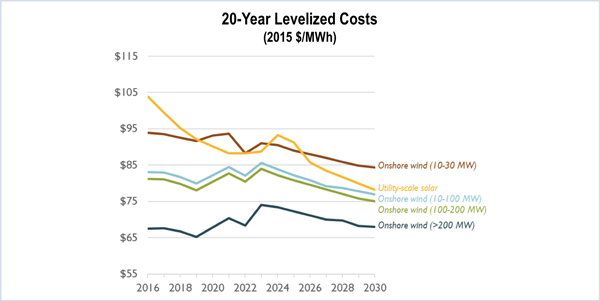By Michael Kuser
Massachusetts regulators have issued new, stricter limits on greenhouse gas emissions from the state’s fossil fuel power plants and ordered utilities to buy at least 16% of their electricity from clean energy sources in 2018.
The regulations, announced Aug. 11 in response to a 2016 court order, include a Clean Energy Standard (CES) that requires utilities and competitive suppliers in the state to procure increasing amounts of electricity from clean energy sources every year, with the minimum percentage increasing 2 points annually to reach 80% in 2050.
The new rules also set annually declining limits on aggregate CO2 emissions from 21 large fossil fuel-fired power plants in the state, from 8.96 million metric tons in 2018 to 1.8 million metric tons in 2050. The regulations establish an allowance trading program for CO2 emissions from generators, with allowance auctions beginning in 2019 and direct allocations for 2018. The rules offer flexibility in the form of limited allowance banking and a “deferred compliance” option to address electricity grid reliability.

allowance prices assumed in the main scenarios, (RGGI price) and alternative sensitivity price | Mass. DOER
The regulations also reduce allowable methane emissions from natural gas pipelines and distribution systems. They also tap the transportation sector by requiring state, city and regional transportation planning agencies to evaluate and report the aggregate GHG emissions of their facilities, fleets and programs.
The new procurement rules are like those of the Massachusetts Renewable Portfolio Standard, while the emissions targets are stricter than CO2 limits under the Regional Greenhouse Gas Initiative, the cap-and-trade system agreed on by nine Northeastern states.
Pushed to Act
The state acted in response to a 2014 lawsuit by the Conservation Law Foundation that accused Massachusetts officials of failing to enact regulations needed to meet the targets set by the 2008 Global Warming Solutions Act. The state’s top court ruled in favor of CLF in May 2016.
CLF helped win passage of the climate change law, which requires Massachusetts to issue regulations to incrementally reduce greenhouse gas emissions each year.
“These rules re-establish the commonwealth as a national leader in developing sensible, enforceable standards to transition our economy to a low-carbon future,” CLF President Bradley Campbell said in a statement. “Much more needs to be done, and Gov. [Charlie] Baker’s leadership will be essential to getting neighboring states to take meaningful action to prepare New England for the energy future being shaped by the Paris Climate Agreement.”

20-year levelized cost of renewable energy resources | Mass. DOER
Last September, Baker issued an executive order that set a deadline of Aug. 11 for the secretary of energy and environmental Affairs and the Department of Environmental Protection to have “designed such regulations to ensure that the commonwealth meets the 2020 statewide emissions limit mandated by the GWSA.”
That limit — a 25% reduction in emissions below 1990 levels — was established seven years ago by the state to meet the GWSA requirement of a minimum 80% reduction by 2050. Officials estimate that by 2014, Massachusetts had already cut carbon emissions by 21% from 1990 levels.
“These regulations will help ensure the commonwealth meets the rigorous emission reductions limits established in the Global Warming Solutions Act in order to protect our residents, communities and natural resources from the effects of climate change,” Baker said.
Limited Effect on Consumers
The DEP concluded that the emissions targets and clean procurement rules would likely increase customer electricity bills by 1 to 2% per year.
The Bay State has been busy this year ramping up its environmental regulations. Officials earlier this summer announced that the state’s electric distribution utilities must procure a combined 200 MWh of energy storage by Jan. 1, 2020. (See Massachusetts Underwhelms with 200-MWh Storage Target.)
In late July, the state received more than half a dozen proposals to meet its call for 9.45 TWh a year of renewable generation. Projects will be selected next January, with contracts to be submitted in late April. (See Hydro-Québec Dominates Mass. Clean Energy Bids.)
In response to public comment, the final CES included limited grandfathering to accommodate electricity sold in 2018 and 2019 under existing contracts. For the next three years, the alternative compliance payment rate is being increased to 75% of the RPS amount, but it will drop to 50% of the RPS amount in 2021. The use of banked clean energy credits is not allowed until 2021.

allowance prices assumed in the main scenarios, (RGGI price) and alternative sensitivity price | Mass. DOER
The RGGI emissions cap represents a regional budget for CO2 emissions from the power sector, with each CO2 allowance representing an authorization to emit 1 short ton from a regulated source. The nine RGGI states agreed on a 2014 cap of 91 million short tons. The CO2 cap declines by 2.5 percentage points each year from 2015 to 2020.


